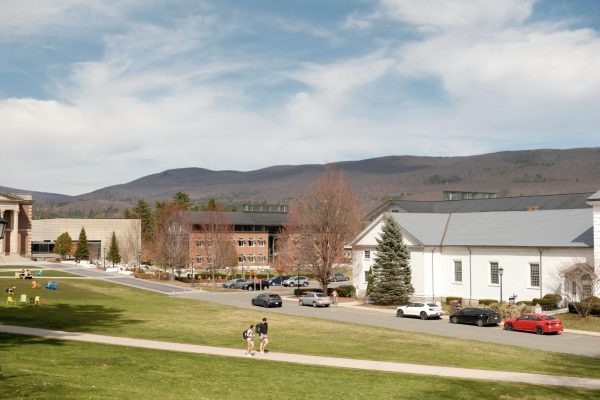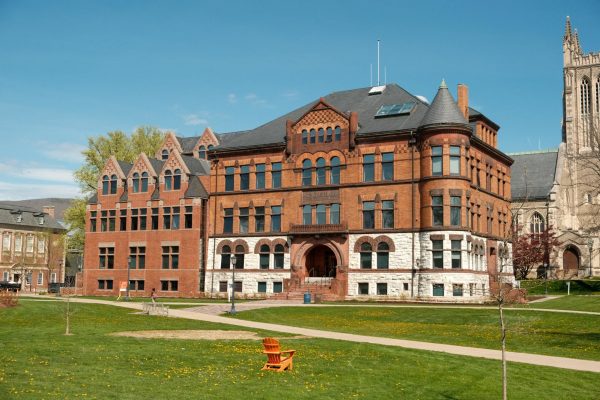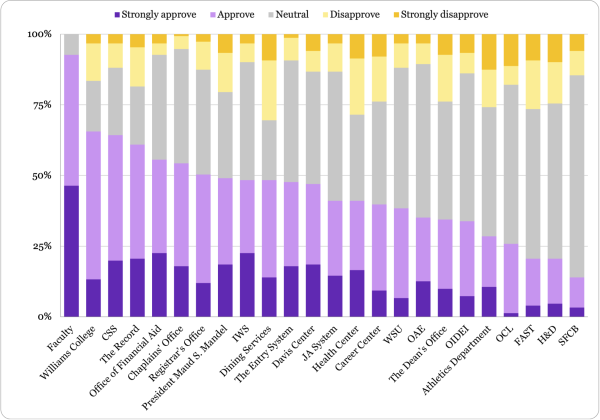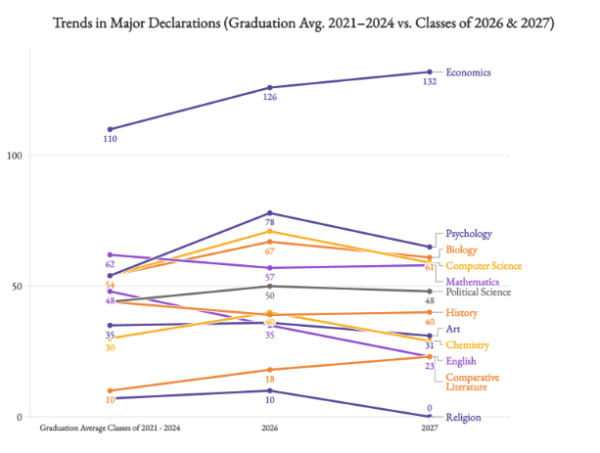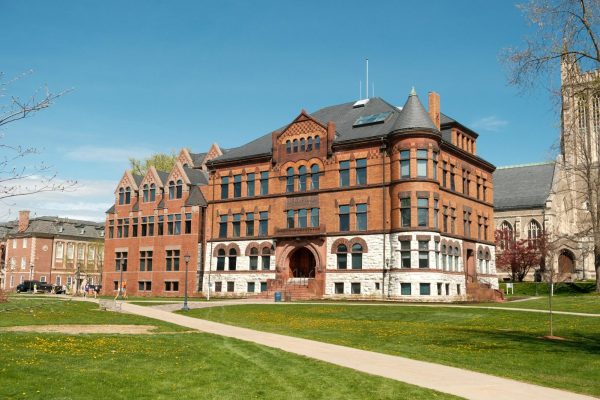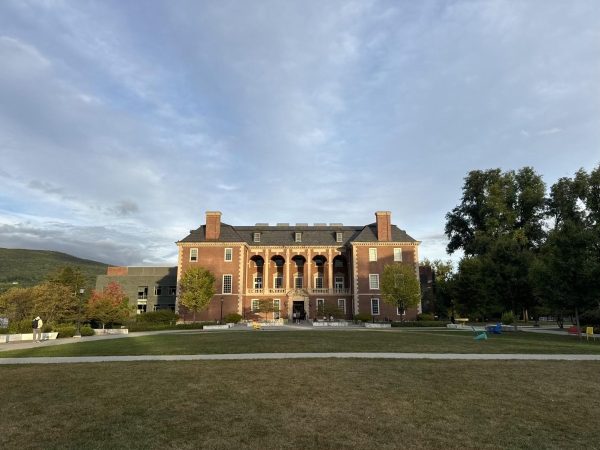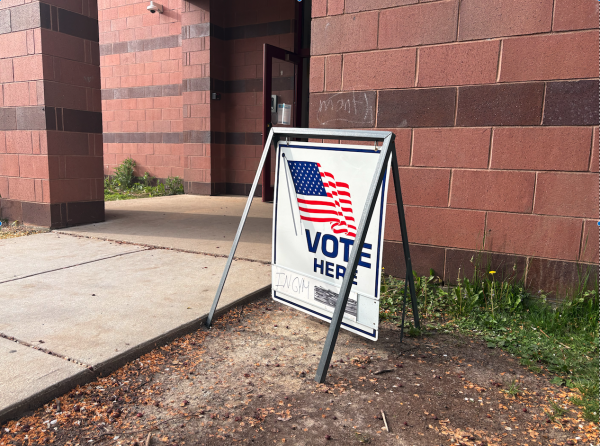A year into the pandemic, staff still face unique burdens

On March 11, 2020, President Maud S. Mandel’s all-campus email was unequivocal: The College would be shutting down all in-person instruction for all students and faculty, effective that week.
“This decision is among the hardest I’ve ever made,” the email read. “My heart goes out to everyone, and especially seniors, for whom this is the last semester on campus.”
But Mandel’s message was less straightforward for the approximately 950 staff members who work at the College, many of them in jobs that could not be done remotely. “We appreciate your commitment to the students and ask you to please report to work as always so that we can manage the transition well,” she wrote. “Williams will still operate, and you will be paid as usual.”
In the year since campus first shut down, those who work in person, such as Facilities and Dining Services staff, have incorporated social distancing, masking, and countless other safety measures into their daily tasks. Meanwhile, those who now work remotely from home, which includes most staff in administrative positions paid on a salary basis, have faced the challenges of finding a work–life balance in a remote setting. For all staff, it has been a year of radical adjustment to the reality of COVID.
A Record survey, sent on March 30 of this year to all 948 College staff members registered in William Students Online, indicates some cause for optimism. Of the survey’s 276 respondents, 71 percent said that the decision to bring students back to campus last fall was a good one; 14 percent said it was not a good decision, and another 14 percent said they weren’t sure.
The numbers represent a modest increase in confidence from a staff survey conducted by the College in August 2020, which found that 29 percent of respondents fully supported the reopening plan, 39 percent supported it but with “significant reservations or concerns,” and 27 percent opposed it.
But this overall confidence should not obscure the diversity of experiences and viewpoints among the hundreds of staff who work at the College.
“Personally answering that question [of how the last year has gone] is going to be different for every single staff member,” said David Keiser-Clark, the academic application developer at the Office for Informational Technology (OIT) and one of two co-chairs of the Staff Committee, an elected staff advocacy body. “So much of it depends on what else is going on in their life, and how that’s impacted them and how they’ve been able to deal or not deal with that.”
In addition to its survey, the Record spoke with four administrative and three support staff — Keiser-Clark, Health Educator Laini Sporbert (the other co-chair of the Staff Committee), Biology Technical Assistant Audrey Werner, and four others who asked to remain anonymous — about their experiences since the pandemic began. The stories they told speak to the challenges staff have confronted in the past year, the ways staff feel they do and don’t fit in at Williams, and the hopes many staff have for a post-COVID future.
A changed workplace
From the very start of the COVID era in March 2020, most staff members’ workplaces have been drastically altered, and a majority said that their work has grown more difficult.
Fifty-four percent of respondents to the Record’s survey said that their work has gotten harder since COVID-19 began, while 36 percent said it has stayed about the same and 9 percent said it has gotten easier.
One staff member who works in OIT said they needed to invest a significant amount of money on home office supplies in order to do their job comfortably from home. “When I moved home, it was not good,” they said. “That went on for a bit until I spent quite a lot of money to try and fix it. Now, I don’t think it’s better or worse. It’s fairly equivalent, except I don’t see people.”
When it comes to helping people with IT-related issues, they said interactions have become less spontaneous and more scripted. “All the people that I would run into and then help them on the spot — that is not happening,” they said. “A lot of the issues that we solve, we say are technology things, but ultimately they have to do with people. And when we’re disconnected from people, bad things happen.”
“[Working from home] was a big learning curve for me, and I wasn’t sure I was going to like it,” said Sporbert, who works within the Dean’s Office in her role as health educator. “But now I’m really used to it. And I’ve found certain things that I really am grateful for, working from home.”
As for in-person staff, one custodian said the nature of their work has changed during the pandemic as student behavior has shifted and new COVID protocols have taken effect. “There’s less partying, so that’s less work for me, but there’s more disinfecting,” they said. “It’s offset by a lot of that stuff, trying to keep the place healthy and clean.”
Werner, who works as a technical assistant in the science laboratories, said she had some choice over whether she would come into the office. “The department did first ask if we were willing to continue working as normal,” she said. “My colleague and I decided that we would definitely still do the labs, just taking precautions.”
Wages and bonuses
In addition to enforcing new rules and sometimes providing extra resources to mitigate COVID’s impact, the College also instituted several pay boosts for staff, including an extra $5 an hour for in-person, high-contact staff in the fall.
Vice President for Finance and Administration and Treasurer Fred Puddester explained that the decision to institute this temporary raise came from the uncertainty during the late summer that accompanied students’ imminent return to campus. “For these essential employees, they had to come to work, they had to come to campus,” he said. “And while we thought we had a safe environment, there was a lot of apprehension because of the uncertainty. So what we did was we provided this $5-an-hour supplement.”
However, the extra hourly pay came to an end in November, when most students left campus and the administration decided that the risk from COVID was relatively low.
“By November, we demonstrated the College was a very safe place to be based on the protocols we have in place, and as a result we don’t think there’s a need to add the extra pay,” Puddester said. “A lot [of staff] were very grateful we did it for as long as we did. Some were surprised we did it for as long as we did, and others were upset that we took it away.”
One staff member, via an anonymous response to an open-ended question on the Record’s survey, expressed their frustration with the policy. “The College stopped paying us the $5.00 an hour COVID-19 ‘Not Hazard’ pay even before all the students had left in the fall, and still does not feel we deserve it again, now,” they said. “Pretty shitty of them, in my eyes. I’m kind of feeling like a pawn in this game, again.”
A custodian who continued working in dorms even after the extra pay ended in November largely agreed with this perspective. “I felt as though they should have at least paid [the COVID supplement] through the end of the year,” they said. “When things got better — that’s when they should have started taking it away from us.”
They added, however, that they were grateful for a bonus they received from the College at the end of 2020. According to Director of Human Resources Danielle Gonzalez, all full-time faculty and staff received a bonus of $1000, while some part-time employees received $500.
“In December we paid out bonuses to faculty and staff that totaled ~$1.4 million,” Gonzalez wrote in an email to the Record. “In addition, we paid ~$3.4 million in ‘Covid time’ over the past year. This is the earnings code used when staff are underemployed in a remote setting, were on staff rotations early in the pandemic, or are actually out of work due to Covid or close contact to someone with Covid.”
Gonzalez added that the total cost of the extra $5 an hour for high-contact workers in the fall was approximately $1.4 million, separate from the $1.4 million the College spent on bonuses.
Overall, opinions from staff members varied on whether the College has done enough to support them. “I feel like the College has handled this incredibly well and adroitly,” Keiser-Clark said. “It’s been impressive, the level of concern and the depth of engagement in terms of meeting such a variety of different possible scenarios.”
“Certainly, if I ran the College in March of 2020, I would have no idea what to do and how to approach it,” Sporbert agreed. “So again, just grateful that, so far, it’s all worked out.”
Some staff members, on the other hand, felt College administrators have not recognized the ways that the past year has been challenging for staff. “I don’t get a sense that they feel that we are working harder or under different kinds of stress, and that we need additional support as well,” one staff member who works at the ’62 Center said. “From my experience [with] Hopkins Hall, it’s almost like a normal year.”
Interactions with students
For many of the College’s staff, particularly those who have continued to work in person, the pandemic has changed their perceptions of and relationships with students.
Not including respondents who said they do not regularly interact with students, 85 percent of respondents said that, in their experience, students tend to follow mask-wearing and social-distancing rules, compared to 12 percent who said students tend to disobey rules. Ninety percent said that students generally listen to them and respect what they have to say, versus 7 percent who said students generally act disrespectfully and ignore them.
“I think they [students] are awesome. I think they have been thoughtful,” the ’62 Center staff member said. “They all have been respectful about social distancing and masks. I have not had any negative interactions or anything to complain about about students.”
Similarly, Werner said that she has “been impressed with the students, with their flexibility and cooperativeness.”
On the other hand, one custodian who spoke with the Record said they have been more cautious around students in part because of the increase in positive cases and high-profile gatherings. “Last semester, someone in Wood [House] had to quarantine, and that was a big deal,” they said. “Now, this semester, God! … When I go into a dorm, I double-mask.”
Similarly, in anonymous survey responses, some staff expressed disapproval toward students’ behavior, particularly in light of recent violations of public health guidelines like the Wood party.
“Students need to stop drinking [at] parties with no mask,” one anonymous respondent said. “They are risking themselves and employees!!!”
“I think the students can be more mindful of the severity of [COVID] and social distance at all times, wear proper PPE [personal protective equipment], and not gather in large groups,” another respondent wrote. “I think the students who disobey the college rules, which they signed and agreed to do, should be more severely penalized for jeopardizing more than just themselves.”
But Keiser-Clark said that, in his conversations with staff, most feel that students have been doing their part to keep the campus safe.
“The pre-return in the fall, and the level of concern specifically around students, was probably one of the greatest variables — whether students would take this seriously or not,” he said. “And the sense that I have is that, by and large… [the return to campus] has been borne out with a great deal of confidence. There’s, I think, a great deal of respect and admiration and trust. Students are pulling their weight.”
The divide between administrative and support positions
The pandemic has also laid bare a split that has long existed in the staff community between support staff who are paid on an hourly basis and administrative staff who receive a fixed salary. For the most part, support staff are far more likely to hold jobs that require in-person work — and are thus put at greater risk should there be an outbreak on campus.
In total, 71 percent of respondents to the Record’s survey said that bringing students back in the fall was a good decision, but the results were clearly divided by category of staff. Eighty-one percent of administrative staff supported the decision to reopen campus to students, while only 62 percent of support staff said so. (The survey’s sample size was 139 administrative staff, 129 support staff, and eight staff who preferred not to say.)
Perhaps counterintuitively, support staff were also less likely to say their work had grown harder since the pandemic began. Among respondents who indicated they were administrative staff, 57 percent said that their work has gotten harder, versus 48 percent among respondents who said they were support staff.
Keiser-Clark said that one of the ways the administrative–support divide has manifested itself is in the ability to do remote work. “For some people, [remote work] has worked in ways that they’ve found to be really positive, because it allows them to be able to be at home with family members, while for others it’s been an incredible strain to juggle workload and parenting,” he said. “And other people have not had that option because they work in jobs which are front-facing.”
One of the custodians who spoke with the Record noted that some in-person jobs carry an increased risk of contracting the virus. “It’s not that [administrative staff] don’t work hard,” they said. “It’s just that we’re a little bit more in danger, I think.”
The staff member from OIT said the main issue they face now is the possibility of burnout, rather than fears of COVID from in-person work. “I feel pretty fortunate to be a salaried employee,” they said. “For my own health and well-being, my biggest concern is making sure that I don’t work so many hours that it’s unhealthy.”
They added that they feel lucky to be on a consistent salary, especially considering the challenges faced by hourly support staff. “I know people in Dining Services who also work in food service somewhere else,” they said. “I can only imagine that if they lost hours from the other job, they need to hold everything together with obligations that they have, and that’s got to be really stressful.”
Several anonymous respondents noted this divide specifically in the context of payment from the College. “The College should pay employees required to be here more money than those who work from home,” one respondent wrote.
“It’s not equitable for some staff to be able to work from home, while others are required to go to work every day and not get additional compensation for the risk,” another anonymous survey respondent said. “The staff in those positions are also some of the lower paid on campus.”
On the question of what would be most equitable, the staff member from OIT argued that “the most vulnerable staff — the support staff, the ones on the lower end of the pay range — are the ones that deserve a disproportionate amount of support.”
Moving forward
With vaccinations opening to all adults in Massachusetts next Monday — and some staff members already vaccinated, several due to their roles as frontline workers — the end of the COVID era may be on the horizon. But many staff said that they hope the pandemic forces a longer-term reckoning with how the College treats its 950 staff members.
“There is, for the first time in the nine years I’ve been at the College, a clear and articulated response from faculty for the importance of staff,” Keiser-Clark said. “I haven’t seen that previously in my work here at the College.”
Yet some of those who spoke with the Record said they are still experiencing the same frustrating feeling of being undervalued within the campus community.
The ’62 Center staff member used Mountain Day as an example of this issue. “On Mountain Day, the word that we get from the College is, ‘It’s Mountain Day, it’s great, let’s go, let’s do this,’” they said. “But it’s not an invitation to the staff. There is an implicit statement that we are not welcome to participate.”
“It’s like the [Purple] Bubble has two layers to it,” they continued. “A lot of us are in the outer layer — we’re looking in, and we’re mostly in, but there is this invisible line between us feeling fully welcomed in this community.”
The Record’s survey itself betrayed anxieties that many staff, particularly support staff, feel about criticizing their workplace. Multiple respondents wrote in response to open-ended questions that they were limiting their answers for fear of retribution. Undoubtedly, some staff members chose not to take the survey at all because they were worried they would be identified.
So what, exactly, would a more equitable College look like for staff? Some suggested increasing staff pay, especially for frontline staff while COVID remains a factor. Others recommended that the College improve its communication going forward, perhaps by making Chief Communications Officer Jim Reische’s weekly operations emails a permanent fixture.
Still others, among them Keiser-Clark, pointed to broader reflections on staff culture that could be made by administrators, faculty members, and students.
“I worry that, after the pandemic, we will revert, sort of like a rubber band, back to normal,” Keiser-Clark said. “I think we’re at an inflection point, and we the nation, we the College, we the students, we the staff — all of us have a new opportunity to try to figure out how we’re going to live with each other and ourselves going forward.”
Irene Loewenson contributed reporting.
The Record is committed to reporting on the experiences of staff during the pandemic. If you’re interested in telling your story, please reach out to [email protected].
Joey Fox ’21 is a history and English major from New York, NY. He was a managing editor, and previously served as a section editor and executive editor...
Nigel Jaffe ’22 is a psychology major from Jersey City, NJ. He is a senior writer. He previously served as the executive editor for news and data. Before...



